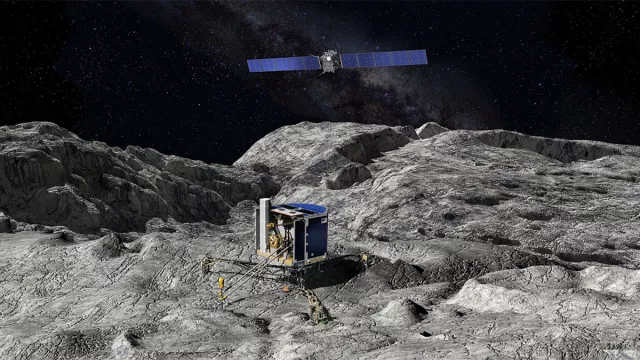The Rosetta spacecraft arrived at comet Churyumov-Gerasimenko (alias ‘Chury’) in 2014, going into orbit and releasing a lander to study the composition of its surface and learn more about how our solar system formed.
Key information
| Mission | Study of comet 67P/Churyumov-Gerasimenko and its behaviour as it approached the Sun |
|---|---|
| Domain | Science |
| Launch date | 2 March 2004 |
| Partners | ESA (initiator), DLR, CSNSM, GRGS, IAS, IPAG, IPGP, IRAP, LAM, LATMOS, LERMA, LESIA, LISA, LPC2E, LPP, OMP |
| Where | In orbit around comet 67P/Churyumov-Gerasimenko and on its surface |
| Lifetime | 12 years (18 months of close observation), mission ended 30 September 2016 |
| Status | Completed |
Key figures
- 3,000 kg: spacecraft mass
- 11 instruments
- 2.8 m x 2.1 m x 2 m: spacecraft dimensions
- 14 contributing French laboratories
Key milestones
- 30 September 2016: Controlled landing of spacecraft on comet and end of mission
- 12 November 2014: Philae module released and lands on comet
- 27 October 2014: ESA selects Philae’s landing site
- 10 September 2014: Rosetta goes into orbit around comet 67P/Churyumov-Gerasimenko
- 20 January 2014: Spacecraft wakes up
- 8 June 2011: Spacecraft put into hibernation
- 10 July 2010: Rosetta flies by asteroid (21) Lutetia
- 13 November 2009: 3rd Earth gravity assist
- 5 September 2008: Rosetta flies by asteroid (2867) Steins
- 13 November 2007: 2nd Earth gravity assist
- 25 February 2007: Mars gravity assist
- 4 March 2005: 1st Earth gravity assist
- 2 March 2004: Rosetta launched by Ariane 5G+
- 24 October 2001: Start of phase C/D of development
- 1993: ESA gives go-ahead to build Rosetta spacecraft
Le projet en bref
In 2004, Europe’s Rosetta probe departed Earth on the start of a 10-year journey to comet Churyumov-Gerasimenko, which it began observing close up in July 2014. Then in November 2014 Rosetta released the Philae lander onto the comet’s surface to analyse it from all angles, studying the composition of its soil, its physical properties and level of activity.
This science phase was designed to deliver new insights into the formation of the solar system. As comets were formed at the same time as our solar system 4½ billion years ago, well before the planets, they offer a glimpse of what conditions were like when it was born.
To accomplish this mission, the orbiter and its lander carried no fewer than 21 instruments (11 on the orbiter, 10 on the lander).
CNES’s role
The Rosetta mission was part of the European Space Agency’s Horizon 2000 programme. France and CNES contributed to the mission in several areas. For the orbiter, CNES oversaw the CONSERT instrument (Comet Nucleus Sounding Experiment by Radiowave Transmission), a radar designed by the IPAG planetology and astrophysics institute in Grenoble, the LATMOS atmospheres, environments and space observations laboratory and the Max Planck Institute for Solar System Research (MPS) in Germany to study the inner structure of the comet’s nucleus. Airbus Defence & Space Germany (formerly EADS Astrium) was the prime contractor for the orbiter. CNES supplied the primary and secondary batteries for the lander.
The agency was also responsible for the mission’s Science Operations and Navigation Centre (SONC) and oversaw development of the CIVA camera (Comet Infrared & Visible Analyser) by the IAS space astrophysics institute in Orsay and the LAM astrophysics laboratory in Marseille.
Contacts
Solar System Planets and Small Bodies subject matter expert
Francis Rocard
E-mail: francis.rocard at cnes.fr


